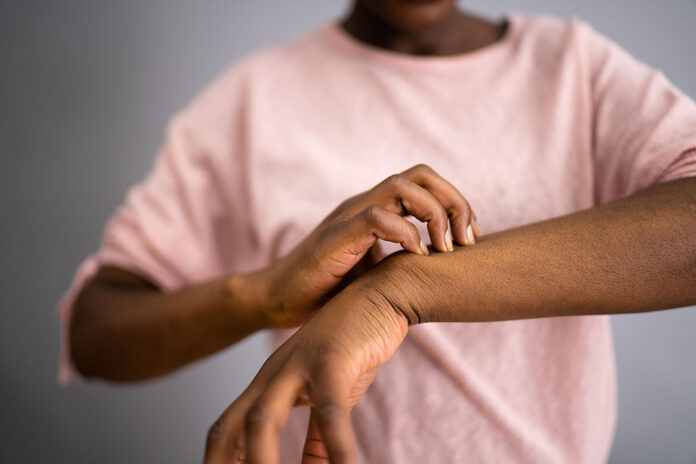Psoriasis is a complex medical condition that can present in a similar way to other conditions that affect the skin. Working with your healthcare provider or dermatologist to accurately diagnose psoriasis is vital because the treatment approaches for different conditions affecting the skin can vary significantly. If there is uncertainty about the diagnosis, a dermatologist or healthcare provider may recommend additional testing to further evaluate the condition in order to differentiate psoriasis from other skin conditions. An accurate diagnosis can help ensure the treatment plan is effective and appropriate.
Similar Conditions
Psoriasis in people of color shares clinical features with several other skin conditions. Understanding key similarities and differences can promote increased awareness and help to combat misdiagnosis of psoriasis.
Cutaneous lupus erythematosus (CLE)
CLE occurs when the autoimmune condition lupus impacts the skin. It presents on the skin in various ways. Associated symptoms include redness, rashes, and lesions. Lesions may appear to be raised or flat, with or without scales, and may be of varying shapes and sizes.
Skin involvement commonly occurs on the face, neck, arms, and other areas that are exposed to sunlight. Sun exposure may worsen the rashes and is a common trigger for CLE flares. It is recommended that individuals with CLE use sun protection measures to minimize the impact.
While psoriasis and CLE share some similarities such as being autoimmune conditions and the presence of skin lesions, they differ in their causes, patterns, and overall presentation.
Hypertrophic lichen planus
The exact cause of lichen planus is not fully understood, but it is believed to be an autoimmune or inflammatory condition. Hypertrophic lichen planus is a subtype of lichen planus characterized by thickened, raised, and sometimes hyperpigmented or reddish-brown lesions.
Physical presentation includes lesions that are shiny and waxy in appearance. These lesions may develop a fine, lace-like pattern on the surface. Unlike psoriasis, these lesions usually don’t have silvery scales. Skin involvement commonly includes the shins, ankles, wrists, lower back, and mucous membranes of the mouth and other areas of the body. Mucous membrane involvement is not a common feature of psoriasis.
Plaque psoriasis and hypertrophic lichen planus may both produce raised skin lesions, but they differ in their causes and affected areas. Additionally, psoriasis is a long-term condition and symptoms do not go away on their own as they usually do in lichen planus.
Cutaneous T-cell lymphoma (CTCL)
CTCL is a form of cancer, and its cells can spread to other parts of the body, including lymph nodes and internal organs. The exact cause is not well-understood. Patients with severe psoriasis are at greater risk of developing CTCL.
It often presents with skin lesions that may resemble psoriasis. Associated symptoms include red, scaly patches or plaques, itching, and skin thickening. Unlike psoriasis, CTCL lesions may not have the typical silvery scales, and they tend to be more persistent and treatment-resistant. CTCL can grow slowly or aggressively. Early-stage CTCL often has a favorable outlook, while advanced stages can be challenging to treat.
Plaque psoriasis and cutaneous T-cell lymphoma may be similar in how they appear on the skin, but they are very different in terms of their causes and treatment. CTCL often requires a more comprehensive evaluation and treatment plan.
Sarcoidosis
Sarcoidosis is an inflammatory disorder that presents with small inflammatory nodules in various organs. The exact cause is unknown, but it is thought to involve an abnormal immune response.
In cutaneous sarcoidosis, skin lesions often appear as firm, reddish-brown plaques. They can show up anywhere on the body, including the face, extremities, and midsection. Unlike psoriasis, skin involvement in sarcoidosis typically does not feature the silvery scales seen in psoriasis.
Both conditions can present with skin lesions, but they have different underlying causes and treatment. If you have concerns that you’ve been misdiagnosed with a skin condition, it is important that you discuss your concerns with your healthcare provider.
If you or someone you know has been diagnosed with plaque psoriasis learn more about the LATITUDE study.
References
- The Journal of Clinical and Aesthetic Dermatology. Special Considerations in the Diagnosis and Treatment of Psoriasis
- JAMA Dermatology Patient Page. Cutaneous Lupus Erythematosus
- Journal of Clinical Medicine. Topographic Differential Diagnosis of Chronic Plaque Psoriasis: Challenges and Tricks
- Metabolism Open. Understanding the enigmatic association between mycosis fungoides and psoriasis: Report of two cases and review of the literature
- JAMA Dermatology Case Report/Case Series. Sarcoidosis and Psoriasis
- A Case Series and Review of the Literature Exploring Co-Incidence vs Coincidence






